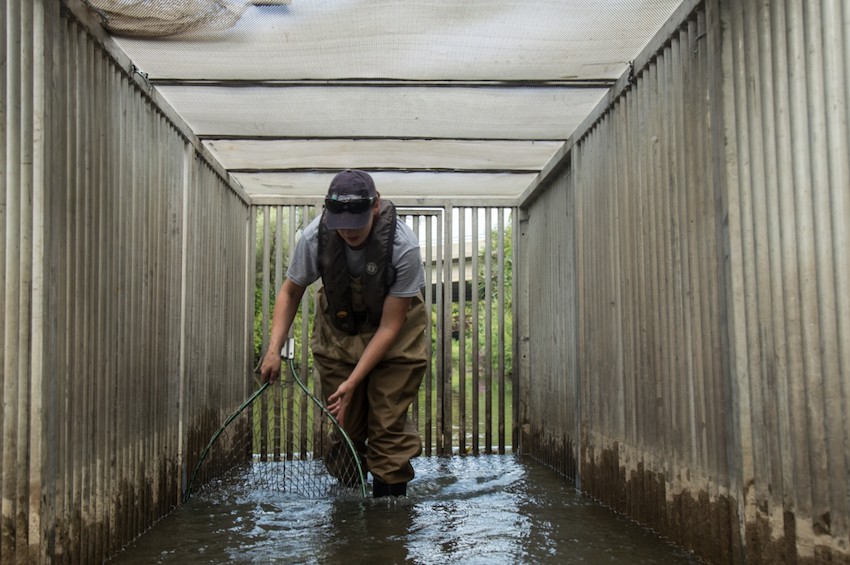2015 was a record year for Atlantic Salmon travelling upstream to spawn in Duffins Creek! Between August 14th and September 22nd, Toronto and Region Conservation’s (TRCA) environmental monitoring team recorded 8 Atlantic Salmon in the temporary Resistance Board Weir set-up near the mouth of the creek.
This is the most Atlantics caught in one season at the Weir since operations began in 2013. The largest Atlantic Salmon captured this year was a male, weighing 4200 g and measuring 695 mm in length!
2015 Atlantic Salmon Catch: Duffins Creek Resistance Board Weir
| Length | Weight | |
| Atlantic #1 | 675 mm | 4200 g (9.24 lbs) |
| Atlantic #2 | 459 mm | 1150 g (2.54 lbs) |
| Atlantic #3 | 464 mm | 1200 g (2.64 lbs) |
| Atlantic #4 | 579 mm | 2200 g (4.85 lbs) |
| Atlantic #5 | 545 mm | 2000 g (4.41 lbs) |
| Atlantic #6 | 570 mm | 2300 g (5.07 lbs) |
| Atlantic #7 | 460 mm | 1500 g (3.21 lbs) |
| Atlantic #8 | 695 mm | 4200 g (9.24 lbs) |
In total for this year’s season, characteristics of 462 Salmonid species were recorded during 37 individual sampling events (780.5 hours) at the Weir before the fish continued their migration upstream.
|
2015 Data Summary: Duffins Creek Resistance Board Weir |
|||||
| Week | Chinook Salmon | Coho Salmon | Brown Trout | Rainbow Trout | Atlantic Salmon |
| Aug-09 |
1 |
0 |
0 |
0 |
1 |
| Aug-16 |
0 |
0 |
0 |
0 |
1 |
| Aug-23 |
4 |
0 |
0 |
0 |
1 |
| Aug-30 |
4 |
1 |
0 |
0 |
0 |
| Sep-06 |
38 |
0 |
1 |
0 |
0 |
| Sep-13 |
93 |
6 |
5 |
0 |
1 |
| Sep-20 |
261 |
37 |
3 |
0 |
4 |
| INDIVIDUAL TOTALS |
401 |
44 |
9 |
0 |
8 |
| BULK TOTALS |
462 |
||||
2015 marks the third year TRCA has been involved in environmental monitoring of all salmonid species migrating upstream in Duffins Creek, in support of the Lake Ontario Atlantic Salmon Restoration Program (LOASRP) program (i.e. Bring Back the Salmon).
Since 2006, the 40+ partners and sponsors for the LOASRP program have been focused on restoring a self-sustaining native Atlantic Salmon population to Lake Ontario since their extirpation (i.e. local extinction) in the late 1800s. Atlantic Salmon were one of the first fish species in the Great Lakes to disappear as a result of degradation of streams, over-fishing and ecosystem changes in the lake.

The fish production and stocking component of the LOASRP focuses on raising three different genetic strains of juvenile Atlantics and subsequently stocking them in a few select Lake Ontario tributaries, including Duffins Creek. All stocked fish are genetically tagged so that any recaptured fish can be traced to specific stocking events or identified as wild recruits.
The expectation is that it will take another decade or more to realize a self-sustaining population of Atlantic Salmon in Lake Ontario. The LOASRP program also includes water quality and habitat enhancement, education and outreach, and research and monitoring activities.

Funded by the Ontario Ministry of Natural Resources and Forestry (OMNRF), TRCA’s environmental monitoring team supports the LOASRP program by both installing the Duffins Creek Resistance Board Weir and recording the characteristics (e.g. length, weight, gill parasites, sea lamprey scars) of all Salmonid species caught during their spawning migration periods.
TRCA also collects genetic samples from Atlantic Salmon caudal fins to assist researchers in determining which strain of stocked fish is proving most successful.
The day-to-day operations of the Duffins Creek Resistance Board Weir are performed in consultation with the OMNRF, who is a lead partner with the Ontario Federation of Anglers and Hunters (OFAH) for the LOASRP’s stream habitat enhancement activities. The Ontario Power Generation (OPG) is the lead sponsor for the LOASRP program, contributing $1.25 million over five years (2011-2015).
How is the Resistance Board Weir set up? Check out this clip!
Monitoring Matters! Through scientific data collection, TRCA’s Environmental Monitoring and Data Management team tell the stories about the changes affecting the natural areas and watercourses within our regions. For more information, please visit our website, follow us on Twitter, subscribe to our Monitoring Matters e-newsletter, or visit our YouTube playlist.
